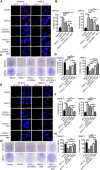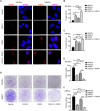The RNA demethylase FTO promotes glutamine metabolism in clear cell renal cell carcinoma through the regulation of SLC1A5
- PMID: 40532011
- PMCID: PMC12175902
- DOI: 10.1126/sciadv.adv2417
The RNA demethylase FTO promotes glutamine metabolism in clear cell renal cell carcinoma through the regulation of SLC1A5
Abstract
Glutamine reprogramming plays a crucial role in the growth and survival of clear cell renal cell carcinoma (ccRCC), although the mechanisms governing its regulation are still not fully understood. We demonstrate that the RNA demethylase fat mass and obesity-associated gene (FTO) drives glutamine reprogramming to support ccRCC growth and survival. Genetic and pharmacologic inhibition of FTO in ccRCC cells impaired glutamine-derived reductive carboxylation, depleted pyrimidines, and increased reactive oxygen species. This led to increased DNA damage and reduced survival, which could be rescued by pyrimidine nucleobases or the antioxidant N-acetylcysteine. Mechanistically, FTO demethylates the glutamine transporter solute carrier family 1 member 5 (SLC1A5) messenger RNA to promote its expression. Restoration of SLC1A5 expression in FTO-knockdown cells rescued metabolic and survival defects. FTO inhibition reduced ccRCC tumor xenograft and PDX growth under the renal capsule. Our findings indicate that FTO is an epitranscriptomic regulator of ccRCC glutamine reprogramming and highlight the therapeutic potential of targeting FTO for the treatment of ccRCC.
Figures






Similar articles
-
Biological and metabolomic insights into RACGAP1-mediated growth and progression of clear cell renal cell carcinoma.Am J Physiol Cell Physiol. 2025 Jul 1;329(1):C283-C297. doi: 10.1152/ajpcell.00066.2025. Epub 2025 Jun 16. Am J Physiol Cell Physiol. 2025. PMID: 40522863
-
The m6A RNA demethylase FTO is a HIF-independent synthetic lethal partner with the VHL tumor suppressor.Proc Natl Acad Sci U S A. 2020 Sep 1;117(35):21441-21449. doi: 10.1073/pnas.2000516117. Epub 2020 Aug 19. Proc Natl Acad Sci U S A. 2020. PMID: 32817424 Free PMC article.
-
ATF4 promotes glutaminolysis and glycolysis in colorectal cancer by transcriptionally inducing SLC1A5.Acta Biochim Biophys Sin (Shanghai). 2024 Dec 17;57(7):1093-1105. doi: 10.3724/abbs.2024226. Acta Biochim Biophys Sin (Shanghai). 2024. PMID: 39696988 Free PMC article.
-
Mechanistic role of FTO in cancer pathogenesis, immune evasion, chemotherapy resistance, and immunotherapy response.Semin Oncol. 2025 Jun;52(3):152368. doi: 10.1016/j.seminoncol.2025.152368. Epub 2025 May 29. Semin Oncol. 2025. PMID: 40446483 Review.
-
Cancer-associated fibroblasts in clear cell renal cell carcinoma: functional heterogeneity, tumor microenvironment crosstalk, and therapeutic opportunities.Front Immunol. 2025 Jun 4;16:1617968. doi: 10.3389/fimmu.2025.1617968. eCollection 2025. Front Immunol. 2025. PMID: 40534854 Free PMC article. Review.
References
-
- Bray F., Ferlay J., Soerjomataram I., Siegel R. L., Torre L. A., Jemal A., Global cancer statistics 2018: GLOBOCAN estimates of incidence and mortality worldwide for 36 cancers in 185 countries. CA Cancer J. Clin. 68, 394–424 (2018). - PubMed
-
- Hutson T. E., Thoreson G. R., Figlin R. A., Rini B. I., The evolution of systemic therapy in metastatic renal cell carcinoma. Am. Soc. Clin. Oncol. Educ. Book 35, 113–117 (2016). - PubMed
-
- Rini B. I., Campbell S. C., Escudier B., Renal cell carcinoma. Lancet 373, 1119–1132 (2009). - PubMed
-
- Siegel R. L., Miller K. D., Fuchs H. E., Jemal A., Cancer statistics, 2022. CA Cancer J. Clin. 72, 7–33 (2022). - PubMed

